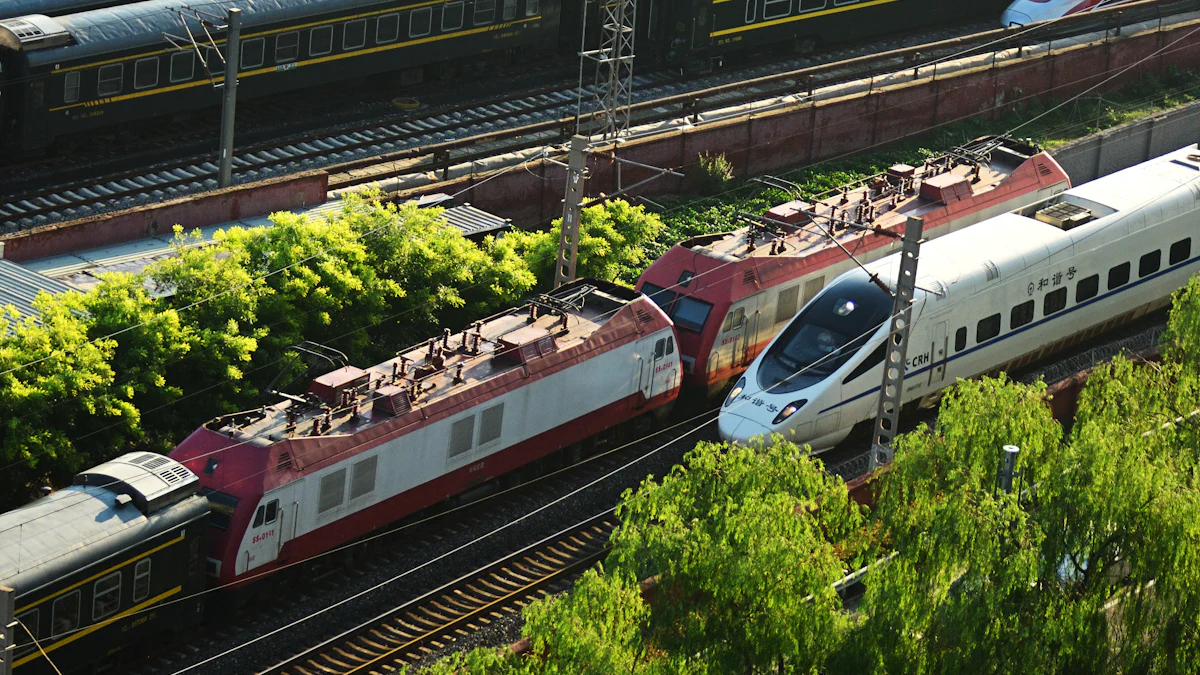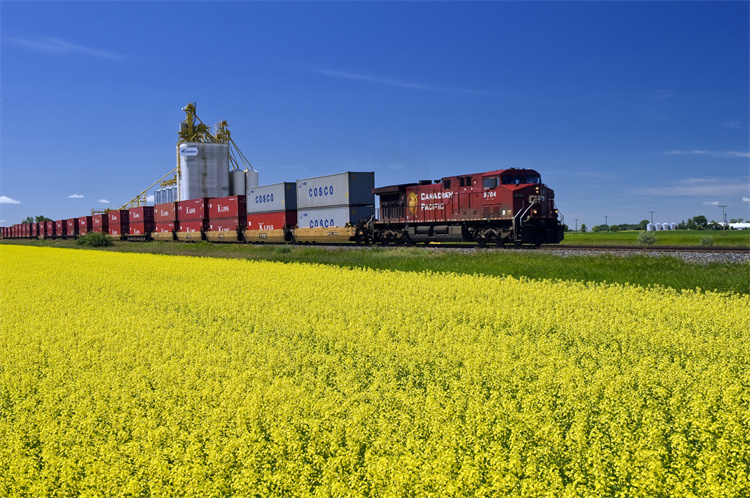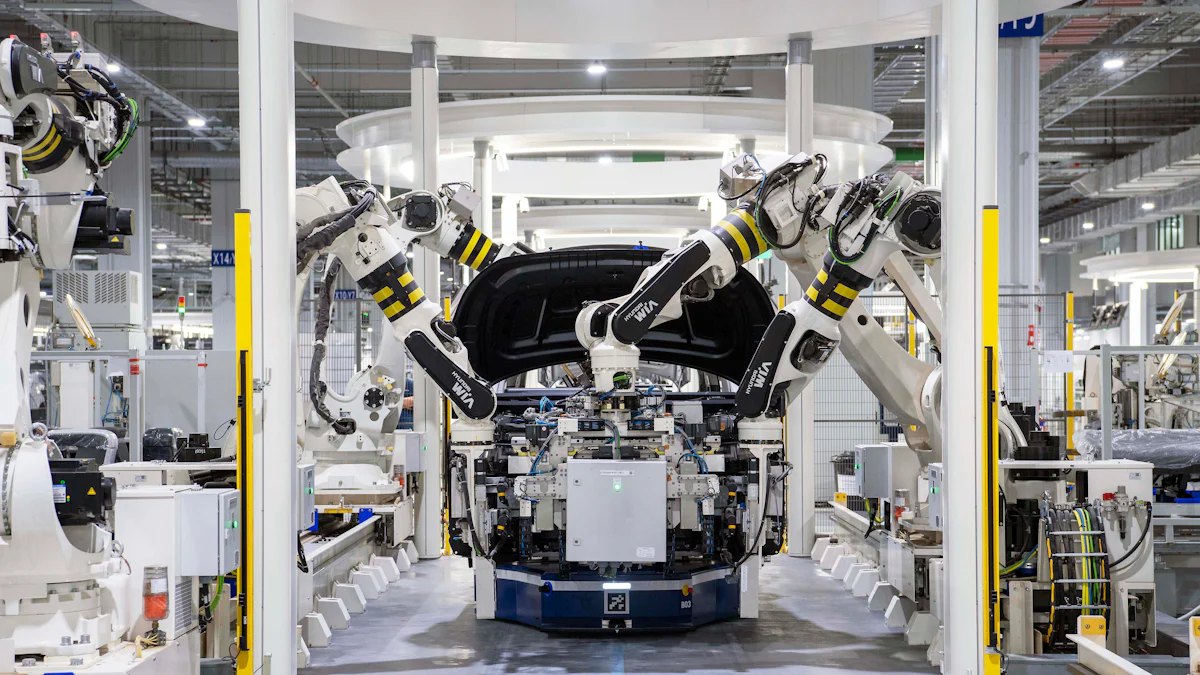Emerging Trends in the China-Europe Railway and Global Rail Transport

Rail transport plays a crucial role in global trade and connectivity. The China-Europe Railway has gained increasing importance, serving as a vital link between the two regions. The railway's rapid growth highlights its significance in international freight forwarding. This blog aims to explore emerging trends in the China-Europe Railway and global rail transport, providing insights into their implications for the future.
Historical Context and Development
Evolution of the China-Europe Railway
Early Beginnings and Initial Routes
The China-Europe Railway Express began its journey in 2008. The first regular rail freight service departed from Xiangtan in Hunan Province and arrived in Hamburg, Germany. This initial route marked a significant milestone in connecting China and Europe through rail transport.
The year 2011 saw the formal establishment of the China-Europe Railway Express. This initiative aimed to create a direct land route between China and Europe. The new route enhanced trade and connectivity across the Eurasian continent. The early routes primarily focused on transporting goods such as electronics, machinery, and textiles.
Major Milestones and Expansions
The China-Europe Railway Express experienced rapid growth and expansion over the years. By 2016, the annual number of freight train trips surged to 1,702. This growth continued, with over 17,000 trips recorded in 2023. The railway's expansion included the development of new routes and the addition of more departure and destination cities.
Strategic partnerships and government support played crucial roles in this expansion. Companies established collaborations with major rail platforms and maintained close relations with governments. These efforts ensured stable capacity and smooth operations. Government subsidies and policies also helped reduce costs and enhance service capabilities.
Global Rail Transport History
Key Developments in Different Regions
Rail transport has a rich history that spans various regions. In Europe, the Industrial Revolution spurred the development of extensive rail networks. Countries like the United Kingdom and Germany led the way in building rail infrastructure. The United States also saw significant rail expansion during the 19th century, connecting the East and West coasts.
Asia witnessed the construction of major railways in the early 20th century. The Trans-Siberian Railway, completed in 1916, connected Moscow to Vladivostok. This railway played a vital role in linking Europe and Asia. Other regions, including Africa and South America, developed rail networks to support their growing economies.
Technological Advancements Over Time
Technological advancements have significantly impacted rail transport. The introduction of steam engines revolutionized early railways. Electric and diesel locomotives later replaced steam engines, offering greater efficiency and speed. High-speed rail emerged as a game-changer in the late 20th century, with countries like Japan and France leading the way.
Digitalization and automation have further transformed rail transport. Smart rail systems now utilize advanced technologies such as AI and big data. These systems optimize supply chain management and enhance decision-making processes. The integration of digital tools ensures real-time monitoring and tracking of various parameters, improving the safety and efficiency of rail operations.
Emerging Trends in Economic Impact
Emerging Trends in Trade and Commerce
Boost to Bilateral Trade Between China and Europe
The China-Europe Railway has significantly boosted bilateral trade between the two regions. Trade volumes grew from 4 trillion yuan in 2013 to 7.42 trillion yuan in 2022. This growth highlights the railway's role in facilitating economic integration. The railway has transported over 50,000 types of goods, including machinery, electronics, and automobiles. Enhanced monitoring and tracking systems ensure the safe and efficient transport of these goods. Real-time monitoring of temperature, humidity, air pressure, and location helps maintain the quality of transported items.

JUSDA's European Railways service specializes in full-container and less-than-container-load services via China-Europe block trains, offering international Eurasian sea-rail intermodal transport and domestic multimodal transport. With over 15 years of rail transport operation experience, JUSDA maintains strategic partnerships with key train platforms, ensuring stable carriage capacity and real-time monitoring of temperature and humidity throughout the journey.
JUSDA offers extensive rail freight services that include full-container and less-than-container-load services via China-Europe block trains. These services are part of their international Eurasian sea-rail intermodal transport and domestic multimodal transport offerings. JUSDA's rail freight services are characterized by real-time monitoring and tracking of temperature and humidity, ensuring high-quality service throughout the journey. They maintain strategic partnerships with key train platforms to guarantee stable carriage capacity.
Comprehensive Monitoring and Tracking: JUSDA offers full temperature, humidity, air pressure, brightness, and acceleration monitoring, along with real-time location tracking throughout the journey.
Fast Customs Clearance: The company provides a fast customs clearance mode, ensuring efficient processing at borders.
Stable Carriage Capacity: JUSDA guarantees stable cabin capacity through strategic partnerships with major rail platforms and close government relations.
Diverse Service Offerings: They provide both full container load (FCL) and less-than-container load (LCL) services, including temperature-controlled containers for China-Europe rail routes.
Intermodal Transport: JUSDA excels in international Eurasian sea-rail intermodal transport and domestic multimodal transport by road, water, and rail.
Extensive Network: The rail services cover over 30 countries across Eurasia, with an annual volume of over 10,000 standard containers.
Experience and Expertise: With over 15 years of rail transport operation experience, JUSDA has accumulated significant expertise in handling high-value cargo.
Customized Solutions: They offer customized special trains for both domestic and international routes, along with last-mile delivery services.
Green Transportation: JUSDA emphasizes energy-saving, emission reduction, and green transportation practices.
Strategic Routes: The company operates several key trains, including the "Zhengxinou," "Hanxinou," "Yuxinou," and "Rongou" trains, among others, connecting major cities and regions.
Resource Integration and Standardization: At destination terminals, JUSDA builds standardized operational capabilities, streamlining drayage services and enhancing customs clearance functions to ensure smooth cargo transfers.
These advantages collectively make JUSDA's European Railways a reliable and efficient option for international rail freight transport.
Impact on Global Supply Chains
The China-Europe Railway has reshaped global supply chains. Companies now rely on this route for faster and more reliable transportation. The railway offers a viable alternative to sea and air freight, reducing transit times and costs. Strategic partnerships and government relations have ensured stable capacity and smooth operations. Government subsidies and policies have further enhanced service capabilities. The integration of rail with other modes of transport, such as sea and road, has created multimodal transport solutions. These solutions enhance the flexibility and efficiency of logistics networks.
Regional Economic Growth
Development of Economic Corridors
The development of economic corridors along the China-Europe Railway has spurred regional economic growth. These corridors have attracted investments in infrastructure and industrial projects. New routes and additional departure and destination cities have expanded the railway's reach. The Middle Corridor has emerged as a key route for transportation. This corridor connects Central Asia, the Caucasus, and Turkey, providing an alternative path to Europe. The expansion into emerging markets, such as China-ASEAN, has diversified market reach and tapped into new opportunities.
Job Creation and Industrial Growth
The China-Europe Railway has contributed to job creation and industrial growth. The development of economic corridors has generated employment opportunities in various sectors. Infrastructure projects, such as the construction of railways and logistics hubs, have created jobs. The growth of direct China-Europe railway services has supported the development of trade and economic cooperation. Customized services and special trains cater to specific customer needs and market demands. These services include high-value and special requirement goods, further driving industrial growth.
Technological Innovations

High-Speed Rail Developments
Advances in Train Technology
High-speed rail technology has revolutionized rail transport. Modern trains now achieve speeds exceeding 300 km/h. Engineers have developed advanced propulsion systems and aerodynamic designs. These innovations reduce travel time and increase efficiency. High-speed trains also offer lower greenhouse gas emissions compared to other transportation modes. Technologies like maglev and hyperloop promise even faster rail speeds in the future.
Implementation of High-Speed Networks
Countries around the world have invested heavily in high-speed rail networks. China has built the world's largest high-speed rail network, spanning over 38,000 kilometers. Europe also boasts extensive high-speed rail connections, linking major cities across the continent. The implementation of these networks has enhanced regional connectivity and economic integration. High-speed rail offers a sustainable alternative to air travel, reducing carbon footprints and easing congestion on roads.
Digitalization and Automation
Smart Rail Systems
Digitalization has transformed rail transport through smart rail systems. These systems utilize advanced technologies such as AI and IoT. Real-time monitoring ensures the safe and efficient operation of trains. Automated systems streamline logistics and reduce human error. Smart rail systems also enhance passenger experience by providing real-time updates and personalized services.
Use of AI and Big Data in Rail Operations
AI and big data have become integral to modern rail operations. Rail companies use AI to predict maintenance needs and optimize schedules. Big data analytics help in managing supply chains and improving decision-making processes. Advanced tracking systems monitor various parameters, ensuring the quality of transported goods. The integration of AI and big data enhances the overall efficiency and reliability of rail transport.
The advancements in high-speed rail and digitalization signify a promising future for global rail transport. These innovations contribute to more convenient, sustainable, and interconnected travel.
Environmental and Social Implications

Sustainability and Green Initiatives
Reduction in Carbon Emissions
The China-Europe Railway has significantly contributed to reducing carbon emissions. Rail transport emits less CO2 compared to air and road transport. The railway emitted approximately 6.2 million tonnes of CO2 equivalent in 2021. This figure highlights the need for continuous mitigation measures. Modern trains equipped with advanced tracking systems further enhance efficiency. These systems ensure optimal fuel usage and reduce unnecessary stops.
Adoption of Renewable Energy Sources
The adoption of renewable energy sources plays a crucial role in the sustainability of the China-Europe Railway. Electric trains powered by renewable energy reduce dependence on fossil fuels. Solar panels and wind turbines installed along rail routes generate clean energy. These green technologies contribute to a lower carbon footprint. The integration of renewable energy aligns with global trends towards sustainability. Governments and companies invest in these technologies to promote eco-friendly transport solutions.
Social Benefits
Improved Connectivity and Accessibility
The China-Europe Railway has improved connectivity and accessibility between regions. The railway connects major cities across China and Europe, facilitating trade and travel. Enhanced connectivity supports economic growth and regional development. The Middle Corridor route provides an alternative path to Europe. This route connects Central Asia, the Caucasus, and Turkey, expanding market reach. Improved rail networks also benefit remote areas, providing access to essential goods and services.
Enhancements in Passenger Experience
Enhancements in passenger experience have been a focus of the China-Europe Railway. Modern trains offer comfortable seating and advanced amenities. High-speed rail reduces travel time, making long-distance journeys more convenient. Digitalization has introduced smart rail systems that provide real-time updates. Passengers receive personalized services through mobile apps and onboard systems. These improvements ensure a pleasant and efficient travel experience for passengers.
Future Prospects and Challenges
Expansion Plans and New Routes
Proposed Projects and Investments
The China-Europe Railway continues to expand with several proposed projects and investments. Governments and private sectors have committed substantial funding to enhance rail infrastructure. The Bipartisan Infrastructure Law (BIL) in the United States has provided new authorities for passenger rail development. This law also allocated significant funds for existing Federal Railroad Administration (FRA) programs. These investments aim to improve connectivity and efficiency in rail transport.
China plans to extend its high-speed rail network to cover more regions. The focus remains on connecting major economic hubs and emerging markets. The FAST Act authorized over $10 billion for intercity passenger and freight rail grants. This funding ensures long-term certainty for surface transportation infrastructure planning and investment. The goal is to create a seamless and integrated rail network that supports global trade.
Potential New Markets and Destinations
The expansion of the China-Europe Railway opens up new markets and destinations. The Middle Corridor has emerged as a key route, connecting Central Asia, the Caucasus, and Turkey. This corridor provides an alternative path to Europe, enhancing market reach. The China-ASEAN route also presents new opportunities for trade and economic cooperation.
Rail companies are exploring customized services for specific customer needs. Special trains for high-value and special requirement goods cater to niche markets. The integration of rail with other transport modes creates multimodal solutions. These solutions enhance the flexibility and efficiency of logistics networks. The expansion into new markets promises diversified growth and increased competitiveness.
Challenges and Obstacles
Political and Regulatory Hurdles
Political and regulatory hurdles pose significant challenges to rail transport. Different countries have varying regulations and standards for rail operations. Compliance with these regulations requires substantial effort and resources. The Railroad Safety initiative ensures the safety of new technologies on the rail network. This initiative mandates adherence to strict safety standards and regulations.
Trade policies and diplomatic relations also impact rail transport. Political tensions can disrupt rail services and affect trade routes. Governments must work together to create a stable and conducive environment for rail transport. International cooperation and agreements play a crucial role in overcoming political barriers.
Technical and Logistical Issues
Technical and logistical issues present obstacles to the smooth operation of rail transport. The integration of advanced technologies requires significant investment and expertise. The Performance-based Regulations framework encourages innovation in rail operations. This framework sets operational goals based on data and performance metrics.
Logistics management involves coordinating various aspects of the supply chain. Real-time monitoring and tracking systems ensure the safe transport of goods. However, implementing these systems requires robust infrastructure and technology. The use of AI and big data enhances decision-making processes and optimizes supply chain management. Addressing technical and logistical challenges is essential for the efficient operation of rail transport.
The future of the China-Europe Railway and global rail transport holds immense potential. Strategic investments and technological advancements promise growth and innovation. However, overcoming political, regulatory, and logistical challenges remains crucial. Continued collaboration and innovation will drive the rail industry towards a sustainable and interconnected future.
The China-Europe Railway and global rail transport play a pivotal role in enhancing trade and connectivity. Key emerging trends include high-speed rail developments, digitalization, and sustainability initiatives. The future outlook suggests continued growth in trade volumes and improved efficiency. Strategic investments and technological advancements promise a sustainable and interconnected future. Continued innovation and collaboration in the rail industry remain essential for achieving these goals.
See Also
Ready to Explore: The Latest in Transport Tech for Supply Chains
Ready for the Transport Tech Revolution Ahead?
Enhancing Supply Chain Efficiency: 5 Impactful Trends
